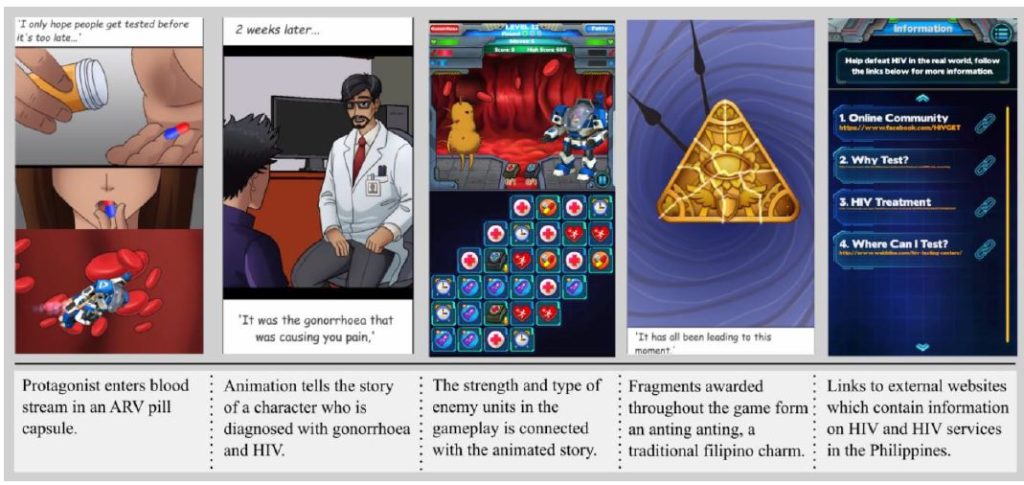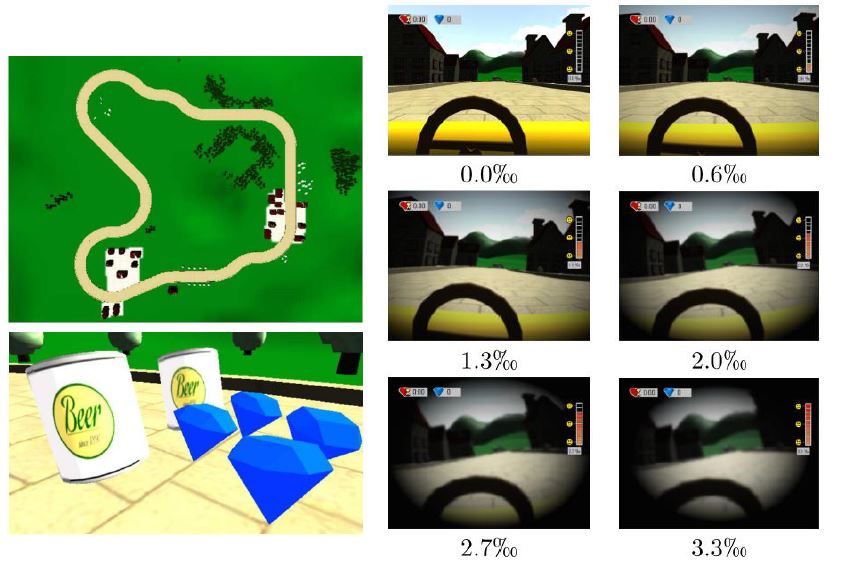(by Lisa Aschenbrenner, Lena Otto and Lorenz Harst)
This is a science blog post of one of our students from the Health Information Management seminar taught by members of Care4 Saxony . In this article, the concept of gamification and its use in the digitalized health care are investigated.
Gamifi-what…? What is this article actually about?
Gamification can be described as the application of game elements in a non-gaming environment and can therefore change behaviour and increase user engagement through positive feedback and rewards
Talking about using mobile devices… what’s the benefit for me?
Mobile applications are particularly promising because they appear more affordable, less invasive and faster intervening than classical medical procedures, while providing direct feedback and a personal, traceable record of activities
Through which kind of wizardry or sorcery are the mentioned applications doing all this?
According to a study, the most important techniques for changing behaviour in smartphone applications are feedback and monitoring, comparison of behaviour as well as reward and threat
I heard about Pokémon Go, that’s pretty much what this is all about, right?
Pokémon Go was in the limelight a few years ago, motivating users to become physically active. But the health potential of apps goes far beyond lifestyle applications, namely when specific diseases are addressed. According to the WHO, chronic diseases are the main driver of mortality, accounting for about 60% of all deaths worldwide
Tell me more…
Diabetes is nowadays the most widespread chronic disease worldwide. For people with diabetes it is important to understand and adhere to their medication and to practice a careful self-management. Self-management means that patients are able to cope with the treatment, symptoms and psychosocial consequences of diseases
I suppose, as so often in literature, there is a framework to better understand all this?
The “Model for Motivational Mobile-health Design for Chronic Conditions” states that three important features play an essential role in mHealth app design, namely condition specific, motivation related, and technology based components
Okay, enough with the theory… Give me more examples!
Breast cancer is the most common cancer among women worldwide and for all those suffering from this disease self-management applications can likewise be beneficial. Here, the focus within existing apps is particularly on treating the symptoms and side effects of chemotherapy, informing about breast health, recording sleep patterns and motivating people to adopt a healthier and more active lifestyle
The game “Re-Mission”, in which cancer patients fight against tumours (https://www.heise.de/newsticker/meldung/Spiel-dich-gesund-2804421.html, 26.01.2020) Is it possible to use the gamification approach preventively, to help before any harm is done?…That would be great!
Clever storytelling can close gaps in knowledge about medical content by guiding users of such applications through a narrative storyline with example patients, thus introducing them to disease prevention measures. Such applications are used, for example, for HIV education in less developed countries
Screenshots of “Battle in the Blood” – a HIV-prevention game [Hemingway, 2019] Another example can be found in the field of addiction prevention, such as the so-called “Drink & Drive” game in which increasing alcohol levels and delayed reactions can be experienced in a racing game. This can be used to point out wrong behaviour patterns in a safe environment but with certain visual and mental stimulus
“Drink & Drive” – experiencing alcohol induced impairments in a gamified setting [Gaibler et al., 2015] You have answered almost all my questions! I just wonder what the future has to offer me anymore?
The mentioned diseases and associated gamification applications are only a tiny fragment of what is possible. Just as large as the multitude of diseases is probably the potential that can still be found in gamification. A look into the future promises a combination of gamification with virtual and augmented reality as well as artificial intelligence
Referenzen
{1908008:VIY8L8F5};{1908008:B9XSXLX3};{1908008:B37PT4AB};{1908008:KRR2F72E};{1908008:B37PT4AB};{1908008:F3ENKWHB};{1908008:B37PT4AB};{1908008:GK7S9FY6};{1908008:B37PT4AB};{1908008:VIY8L8F5};{1908008:B37PT4AB};{1908008:VIY8L8F5};{1908008:B37PT4AB};{1908008:68P5Q7BI};{1908008:7FYCWHNZ};{1908008:5K92U9Z2};{1908008:68P5Q7BI} apa author asc no 2136
%7B%22status%22%3A%22success%22%2C%22updateneeded%22%3Afalse%2C%22instance%22%3A%22zotpress-51ce61351f68025fd523373fed5ef064%22%2C%22meta%22%3A%7B%22request_last%22%3A0%2C%22request_next%22%3A0%2C%22used_cache%22%3Atrue%7D%2C%22data%22%3A%5B%7B%22key%22%3A%22VIY8L8F5%22%2C%22library%22%3A%7B%22id%22%3A1908008%7D%2C%22meta%22%3A%7B%22creatorSummary%22%3A%22AlMarshedi%20et%20al.%22%2C%22parsedDate%22%3A%222016%22%2C%22numChildren%22%3A0%7D%2C%22bib%22%3A%22%3Cdiv%20class%3D%5C%22csl-bib-body%5C%22%20style%3D%5C%22line-height%3A%202%3B%20padding-left%3A%201em%3B%20text-indent%3A-1em%3B%5C%22%3E%5Cn%20%20%3Cdiv%20class%3D%5C%22csl-entry%5C%22%3EAlMarshedi%2C%20A.%2C%20Wills%2C%20G.%2C%20%26amp%3B%20Ranchhod%2C%20A.%20%282016%29.%20Gamifying%20Self-Management%20of%20Chronic%20Illnesses%3A%20A%20Mixed-Methods%20Study.%20%3Ci%3EJMIR%20Serious%20Games%3C%5C%2Fi%3E%2C%20%3Ci%3E4%3C%5C%2Fi%3E%282%29%2C%20e14.%20%3Ca%20href%3D%27https%3A%5C%2F%5C%2Fdoi.org%5C%2F10.2196%5C%2Fgames.5943%27%3Ehttps%3A%5C%2F%5C%2Fdoi.org%5C%2F10.2196%5C%2Fgames.5943%3C%5C%2Fa%3E%3C%5C%2Fdiv%3E%5Cn%3C%5C%2Fdiv%3E%22%2C%22data%22%3A%7B%22itemType%22%3A%22journalArticle%22%2C%22title%22%3A%22Gamifying%20Self-Management%20of%20Chronic%20Illnesses%3A%20A%20Mixed-Methods%20Study%22%2C%22creators%22%3A%5B%7B%22creatorType%22%3A%22author%22%2C%22firstName%22%3A%22Alaa%22%2C%22lastName%22%3A%22AlMarshedi%22%7D%2C%7B%22creatorType%22%3A%22author%22%2C%22firstName%22%3A%22Gary%22%2C%22lastName%22%3A%22Wills%22%7D%2C%7B%22creatorType%22%3A%22author%22%2C%22firstName%22%3A%22Ashok%22%2C%22lastName%22%3A%22Ranchhod%22%7D%5D%2C%22abstractNote%22%3A%22Background%3A%20Self-management%20of%20chronic%20illnesses%20is%20an%20ongoing%20issue%20in%20health%20care%20research.%20Gamification%20is%20a%20concept%20that%20arose%20in%20the%20field%20of%20computer%20science%20and%20has%20been%20borrowed%20by%20many%20other%20disciplines.%20It%20is%20perceived%20by%20many%20that%20gamification%20can%20improve%20the%20self-management%20experience%20of%20people%20with%20chronic%20illnesses.%20This%20paper%20discusses%20the%20validation%20of%20a%20framework%20%28called%20The%20Wheel%20of%20Sukr%29%20that%20was%20introduced%20to%20achieve%20this%20goal.%20Objective%3A%20This%20research%20aims%20to%20%281%29%20discuss%20a%20gamification%20framework%20targeting%20the%20self-management%20of%20chronic%20illnesses%20and%20%282%29%20validate%20the%20framework%20by%20diabetic%20patients%2C%20medical%20professionals%2C%20and%20game%20experts.%20Methods%3A%20A%20mixed-method%20approach%20was%20used%20to%20validate%20the%20framework.%20Expert%20interviews%20%28N%3D8%29%20were%20conducted%20in%20order%20to%20validate%20the%20themes%20of%20the%20framework.%20Additionally%2C%20diabetic%20participants%20completed%20a%20questionnaire%20%28N%3D42%29%20in%20order%20to%20measure%20their%20attitudes%20toward%20the%20themes%20of%20the%20framework.%20Results%3A%20The%20results%20provide%20a%20validation%20of%20the%20framework.%20This%20indicates%20that%20gamification%20might%20improve%20the%20self-management%20of%20chronic%20illnesses%2C%20such%20as%20diabetes.%20Namely%2C%20the%20eight%20themes%20in%20the%20Wheel%20of%20Sukr%20%28fun%2C%20esteem%2C%20socializing%2C%20self-management%2C%20self-representation%2C%20motivation%2C%20growth%2C%20sustainability%29%20were%20perceived%20positively%20by%2071%25%20%2830%5C%2F42%29%20of%20the%20participants%20with%20P%20value%20%3C.001.%20Conclusions%3A%20In%20this%20research%2C%20both%20the%20interviews%20and%20the%20questionnaire%20yielded%20positive%20results%20that%20validate%20the%20framework%20%28The%20Wheel%20of%20Sukr%29.%20Generally%2C%20this%20study%20indicates%20an%20overall%20acceptance%20of%20the%20notion%20of%20gamification%20in%20the%20self-management%20of%20diabetes.%20%20%5BJMIR%20Serious%20Games%202016%3B4%282%29%3Ae14%5D%22%2C%22date%22%3A%222016%22%2C%22language%22%3A%22en%22%2C%22DOI%22%3A%2210.2196%5C%2Fgames.5943%22%2C%22ISSN%22%3A%22%22%2C%22url%22%3A%22https%3A%5C%2F%5C%2Fgames.jmir.org%5C%2F2016%5C%2F2%5C%2Fe14%5C%2F%22%2C%22collections%22%3A%5B%5D%2C%22dateModified%22%3A%222020-01-30T12%3A59%3A26Z%22%7D%7D%2C%7B%22key%22%3A%22F3ENKWHB%22%2C%22library%22%3A%7B%22id%22%3A1908008%7D%2C%22meta%22%3A%7B%22creatorSummary%22%3A%22Edwards%20et%20al.%22%2C%22parsedDate%22%3A%222016-10-01%22%2C%22numChildren%22%3A0%7D%2C%22bib%22%3A%22%3Cdiv%20class%3D%5C%22csl-bib-body%5C%22%20style%3D%5C%22line-height%3A%202%3B%20padding-left%3A%201em%3B%20text-indent%3A-1em%3B%5C%22%3E%5Cn%20%20%3Cdiv%20class%3D%5C%22csl-entry%5C%22%3EEdwards%2C%20E.%20A.%2C%20Lumsden%2C%20J.%2C%20Rivas%2C%20C.%2C%20Steed%2C%20L.%2C%20Edwards%2C%20L.%20A.%2C%20Thiyagarajan%2C%20A.%2C%20Sohanpal%2C%20R.%2C%20Caton%2C%20H.%2C%20Griffiths%2C%20C.%20J.%2C%20Munaf%26%23xF2%3B%2C%20M.%20R.%2C%20Taylor%2C%20S.%2C%20%26amp%3B%20Walton%2C%20R.%20T.%20%282016%29.%20Gamification%20for%20health%20promotion%3A%20systematic%20review%20of%20behaviour%20change%20techniques%20in%20smartphone%20apps.%20%3Ci%3EBMJ%20Open%3C%5C%2Fi%3E%2C%20%3Ci%3E6%3C%5C%2Fi%3E%2810%29.%20%3Ca%20href%3D%27https%3A%5C%2F%5C%2Fdoi.org%5C%2F10.1136%5C%2Fbmjopen-2016-012447%27%3Ehttps%3A%5C%2F%5C%2Fdoi.org%5C%2F10.1136%5C%2Fbmjopen-2016-012447%3C%5C%2Fa%3E%3C%5C%2Fdiv%3E%5Cn%3C%5C%2Fdiv%3E%22%2C%22data%22%3A%7B%22itemType%22%3A%22journalArticle%22%2C%22title%22%3A%22Gamification%20for%20health%20promotion%3A%20systematic%20review%20of%20behaviour%20change%20techniques%20in%20smartphone%20apps%22%2C%22creators%22%3A%5B%7B%22creatorType%22%3A%22author%22%2C%22firstName%22%3A%22E.%20A.%22%2C%22lastName%22%3A%22Edwards%22%7D%2C%7B%22creatorType%22%3A%22author%22%2C%22firstName%22%3A%22J.%22%2C%22lastName%22%3A%22Lumsden%22%7D%2C%7B%22creatorType%22%3A%22author%22%2C%22firstName%22%3A%22C.%22%2C%22lastName%22%3A%22Rivas%22%7D%2C%7B%22creatorType%22%3A%22author%22%2C%22firstName%22%3A%22L.%22%2C%22lastName%22%3A%22Steed%22%7D%2C%7B%22creatorType%22%3A%22author%22%2C%22firstName%22%3A%22L.%20A.%22%2C%22lastName%22%3A%22Edwards%22%7D%2C%7B%22creatorType%22%3A%22author%22%2C%22firstName%22%3A%22A.%22%2C%22lastName%22%3A%22Thiyagarajan%22%7D%2C%7B%22creatorType%22%3A%22author%22%2C%22firstName%22%3A%22R.%22%2C%22lastName%22%3A%22Sohanpal%22%7D%2C%7B%22creatorType%22%3A%22author%22%2C%22firstName%22%3A%22H.%22%2C%22lastName%22%3A%22Caton%22%7D%2C%7B%22creatorType%22%3A%22author%22%2C%22firstName%22%3A%22C.%20J.%22%2C%22lastName%22%3A%22Griffiths%22%7D%2C%7B%22creatorType%22%3A%22author%22%2C%22firstName%22%3A%22M.%20R.%22%2C%22lastName%22%3A%22Munaf%5Cu00f2%22%7D%2C%7B%22creatorType%22%3A%22author%22%2C%22firstName%22%3A%22S.%22%2C%22lastName%22%3A%22Taylor%22%7D%2C%7B%22creatorType%22%3A%22author%22%2C%22firstName%22%3A%22R.%20T.%22%2C%22lastName%22%3A%22Walton%22%7D%5D%2C%22abstractNote%22%3A%22Objective%20Smartphone%20games%20that%20aim%20to%20alter%20health%20behaviours%20are%20common%2C%20but%20there%20is%20uncertainty%20about%20how%20to%20achieve%20this.%20We%20systematically%20reviewed%20health%20apps%20containing%20gaming%20elements%20analysing%20their%20embedded%20behaviour%20change%20techniques.%5CnMethods%20Two%20trained%20researchers%20independently%20coded%20apps%20for%20behaviour%20change%20techniques%20using%20a%20standard%20taxonomy.%20We%20explored%20associations%20with%20user%20ratings%20and%20price.%5CnData%20sources%20We%20screened%20the%20National%20Health%20Service%20%28NHS%29%20Health%20Apps%20Library%20and%20all%20top-rated%20medical%2C%20health%20and%20wellness%20and%20health%20and%20fitness%20apps%20%28defined%20by%20Apple%20and%20Google%20Play%20stores%20based%20on%20revenue%20and%20downloads%29.%20We%20included%20free%20and%20paid%20English%20language%20apps%20using%20%5Cu2018gamification%5Cu2019%20%28rewards%2C%20prizes%2C%20avatars%2C%20badges%2C%20leaderboards%2C%20competitions%2C%20levelling-up%20or%20health-related%20challenges%29.%20We%20excluded%20apps%20targeting%20health%20professionals.%5CnResults%2064%20of%201680%20%284%25%29%20health%20apps%20included%20gamification%20and%20met%20inclusion%20criteria%3B%20only%203%20of%20these%20were%20in%20the%20NHS%20Library.%20Behaviour%20change%20categories%20used%20were%3A%20feedback%20and%20monitoring%20%28n%3D60%2C%2094%25%20of%20apps%29%2C%20reward%20and%20threat%20%28n%3D52%2C%2081%25%29%2C%20and%20goals%20and%20planning%20%28n%3D52%2C%2081%25%29.%20Individual%20techniques%20were%3A%20self-monitoring%20of%20behaviour%20%28n%3D55%2C%2086%25%29%2C%20non-specific%20reward%20%28n%3D49%2C%2082%25%29%2C%20social%20support%20unspecified%20%28n%3D48%2C%2075%25%29%2C%20non-specific%20incentive%20%28n%3D49%2C%2082%25%29%20and%20focus%20on%20past%20success%20%28n%3D47%2C%2073%25%29.%20Median%20number%20of%20techniques%20per%20app%20was%2014%20%28range%3A%205%5Cu201322%29.%20Common%20combinations%20were%3A%20goal%20setting%2C%20self-monitoring%2C%20non-specific%20reward%20and%20non-specific%20incentive%20%28n%3D35%2C%2055%25%29%3B%20goal%20setting%2C%20self-monitoring%20and%20focus%20on%20past%20success%20%28n%3D33%2C%2052%25%29.%20There%20was%20no%20correlation%20between%20number%20of%20techniques%20and%20user%20ratings%20%28p%3D0.07%3B%20rs%3D0.23%29%20or%20price%20%28p%3D0.45%3B%20rs%3D0.10%29.%5CnConclusions%20Few%20health%20apps%20currently%20employ%20gamification%20and%20there%20is%20a%20wide%20variation%20in%20the%20use%20of%20behaviour%20change%20techniques%2C%20which%20may%20limit%20potential%20to%20improve%20health%20outcomes.%20We%20found%20no%20correlation%20between%20user%20rating%20%28a%20possible%20proxy%20for%20health%20benefits%29%20and%20game%20content%20or%20price.%20Further%20research%20is%20required%20to%20evaluate%20effective%20behaviour%20change%20techniques%20and%20to%20assess%20clinical%20outcomes.%5CnTrial%20registration%20number%20CRD42015029841.%22%2C%22date%22%3A%222016%5C%2F10%5C%2F01%22%2C%22language%22%3A%22en%22%2C%22DOI%22%3A%2210.1136%5C%2Fbmjopen-2016-012447%22%2C%22ISSN%22%3A%222044-6055%2C%202044-6055%22%2C%22url%22%3A%22https%3A%5C%2F%5C%2Fbmjopen.bmj.com%5C%2Fcontent%5C%2F6%5C%2F10%5C%2Fe012447%22%2C%22collections%22%3A%5B%5D%2C%22dateModified%22%3A%222020-01-30T12%3A59%3A26Z%22%7D%7D%2C%7B%22key%22%3A%225K92U9Z2%22%2C%22library%22%3A%7B%22id%22%3A1908008%7D%2C%22meta%22%3A%7B%22creatorSummary%22%3A%22Gaibler%20et%20al.%22%2C%22parsedDate%22%3A%222015-09%22%2C%22numChildren%22%3A0%7D%2C%22bib%22%3A%22%3Cdiv%20class%3D%5C%22csl-bib-body%5C%22%20style%3D%5C%22line-height%3A%202%3B%20padding-left%3A%201em%3B%20text-indent%3A-1em%3B%5C%22%3E%5Cn%20%20%3Cdiv%20class%3D%5C%22csl-entry%5C%22%3EGaibler%2C%20F.%2C%20Faber%2C%20S.%2C%20Edenhofer%2C%20S.%2C%20%26amp%3B%20von%20Mammen%2C%20S.%20%282015%29.%20Drink%20amp%3B%20Drive%3A%20A%20Serious%20but%20Fun%20Game%20on%20Alcohol-Induced%20Impairments%20in%20Road%20Traffic.%20%3Ci%3E2015%207th%20International%20Conference%20on%20Games%20and%20Virtual%20Worlds%20for%20Serious%20Applications%20%28VS-Games%29%3C%5C%2Fi%3E%2C%201%26%23x2013%3B5.%20%3Ca%20href%3D%27https%3A%5C%2F%5C%2Fdoi.org%5C%2F10.1109%5C%2FVS-GAMES.2015.7295771%27%3Ehttps%3A%5C%2F%5C%2Fdoi.org%5C%2F10.1109%5C%2FVS-GAMES.2015.7295771%3C%5C%2Fa%3E%3C%5C%2Fdiv%3E%5Cn%3C%5C%2Fdiv%3E%22%2C%22data%22%3A%7B%22itemType%22%3A%22conferencePaper%22%2C%22title%22%3A%22Drink%20amp%3B%20Drive%3A%20A%20Serious%20but%20Fun%20Game%20on%20Alcohol-Induced%20Impairments%20in%20Road%20Traffic%22%2C%22creators%22%3A%5B%7B%22creatorType%22%3A%22author%22%2C%22firstName%22%3A%22Frank%22%2C%22lastName%22%3A%22Gaibler%22%7D%2C%7B%22creatorType%22%3A%22author%22%2C%22firstName%22%3A%22Simon%22%2C%22lastName%22%3A%22Faber%22%7D%2C%7B%22creatorType%22%3A%22author%22%2C%22firstName%22%3A%22Sarah%22%2C%22lastName%22%3A%22Edenhofer%22%7D%2C%7B%22creatorType%22%3A%22author%22%2C%22firstName%22%3A%22Sebastian%22%2C%22lastName%22%3A%22von%20Mammen%22%7D%5D%2C%22abstractNote%22%3A%22In%20this%20paper%2C%20we%20present%20Drink%20%26%20Drive%2C%20a%20serious%20game%20about%20the%20effects%20of%20alcohol%20in%20individual%20transport.%20Although%20there%20were%20a%20few%20projects%20in%20place%2C%20we%20were%20eager%20to%20offer%20a%20more%20attractive%20gaming%20experience%20compared%20to%20the%20preceding%20projects%2C%20especially%20as%20the%20effects%20of%20drunk%20driving%20should%20be%20communicated%20to%20a%20young%20audience.%20Drink%20%26%20Drive%20implements%20a%20competitive%20third-person%20racing%20game%20relying%20on%20well-known%20game%20mechanics.%20The%20goal%20of%20Drink%20%26%20Drive%20is%20the%20motivation%20of%20a%20safe%20arrival%20by%20systematically%20avoiding%20any%20alcoholic%20beverages%20if%20driving.%20Accordingly%2C%20collectibles%20on%20the%20track%20can%20influence%20the%20driver%27s%20state%20of%20perception%2C%20for%20the%20better%20and%20for%20the%20worse.%20The%20delicate%20balance%20between%20serious%20contents%20and%20gaming%20fun%20is%20established%20by%20placing%20great%20emphasis%20on%20a%20clear%2C%20playful%20design%20and%20the%20introduction%20of%20effective%20gamification%20elements%20that%20support%20an%20immersive%2C%20intrinsically%20motivating%20experience.%20In%20this%20paper%2C%20we%20motivate%20and%20present%20the%20design%20of%20Drink%20%26%20Drive%2C%20we%20embed%20it%20into%20the%20context%20of%20related%20works%20and%20we%20provide%20preliminary%20results%20based%20on%20its%20presentation%20to%20forty%20students%20and%20faculty.%22%2C%22date%22%3A%22Sep.%202015%22%2C%22proceedingsTitle%22%3A%222015%207th%20International%20Conference%20on%20Games%20and%20Virtual%20Worlds%20for%20Serious%20Applications%20%28VS-Games%29%22%2C%22conferenceName%22%3A%222015%207th%20International%20Conference%20on%20Games%20and%20Virtual%20Worlds%20for%20Serious%20Applications%20%28VS-Games%29%22%2C%22language%22%3A%22%22%2C%22DOI%22%3A%2210.1109%5C%2FVS-GAMES.2015.7295771%22%2C%22ISBN%22%3A%22%22%2C%22url%22%3A%22%22%2C%22collections%22%3A%5B%5D%2C%22dateModified%22%3A%222020-01-30T12%3A59%3A26Z%22%7D%7D%2C%7B%22key%22%3A%22B9XSXLX3%22%2C%22library%22%3A%7B%22id%22%3A1908008%7D%2C%22meta%22%3A%7B%22creatorSummary%22%3A%22Gallagher%20et%20al.%22%2C%22parsedDate%22%3A%222019-05-01%22%2C%22numChildren%22%3A0%7D%2C%22bib%22%3A%22%3Cdiv%20class%3D%5C%22csl-bib-body%5C%22%20style%3D%5C%22line-height%3A%202%3B%20padding-left%3A%201em%3B%20text-indent%3A-1em%3B%5C%22%3E%5Cn%20%20%3Cdiv%20class%3D%5C%22csl-entry%5C%22%3EGallagher%2C%20R.%2C%20Chow%2C%20C.%2C%20Parker%2C%20H.%2C%20Neubeck%2C%20L.%2C%20Celermajer%2C%20D.%2C%20Redfern%2C%20J.%2C%20Tofler%2C%20G.%2C%20Buckley%2C%20T.%2C%20Schumacher%2C%20T.%2C%20Ferry%2C%20C.%2C%20Whitley%2C%20A.%2C%20Chen%2C%20L.%2C%20%26amp%3B%20Figtree%2C%20G.%20%282019%29.%20Design%20and%20rationale%20of%20the%20MyHeartMate%20study%3A%20a%20randomised%20controlled%20trial%20of%20a%20game-based%20app%20to%20promote%20behaviour%20change%20in%20patients%20with%20cardiovascular%20disease.%20%3Ci%3EBMJ%20Open%3C%5C%2Fi%3E%2C%20%3Ci%3E9%3C%5C%2Fi%3E%285%29.%20%3Ca%20href%3D%27https%3A%5C%2F%5C%2Fdoi.org%5C%2F10.1136%5C%2Fbmjopen-2018-024269%27%3Ehttps%3A%5C%2F%5C%2Fdoi.org%5C%2F10.1136%5C%2Fbmjopen-2018-024269%3C%5C%2Fa%3E%3C%5C%2Fdiv%3E%5Cn%3C%5C%2Fdiv%3E%22%2C%22data%22%3A%7B%22itemType%22%3A%22journalArticle%22%2C%22title%22%3A%22Design%20and%20rationale%20of%20the%20MyHeartMate%20study%3A%20a%20randomised%20controlled%20trial%20of%20a%20game-based%20app%20to%20promote%20behaviour%20change%20in%20patients%20with%20cardiovascular%20disease%22%2C%22creators%22%3A%5B%7B%22creatorType%22%3A%22author%22%2C%22firstName%22%3A%22Robyn%22%2C%22lastName%22%3A%22Gallagher%22%7D%2C%7B%22creatorType%22%3A%22author%22%2C%22firstName%22%3A%22Clara%22%2C%22lastName%22%3A%22Chow%22%7D%2C%7B%22creatorType%22%3A%22author%22%2C%22firstName%22%3A%22Helen%22%2C%22lastName%22%3A%22Parker%22%7D%2C%7B%22creatorType%22%3A%22author%22%2C%22firstName%22%3A%22Lis%22%2C%22lastName%22%3A%22Neubeck%22%7D%2C%7B%22creatorType%22%3A%22author%22%2C%22firstName%22%3A%22David%22%2C%22lastName%22%3A%22Celermajer%22%7D%2C%7B%22creatorType%22%3A%22author%22%2C%22firstName%22%3A%22Julie%22%2C%22lastName%22%3A%22Redfern%22%7D%2C%7B%22creatorType%22%3A%22author%22%2C%22firstName%22%3A%22Geoffrey%22%2C%22lastName%22%3A%22Tofler%22%7D%2C%7B%22creatorType%22%3A%22author%22%2C%22firstName%22%3A%22Thomas%22%2C%22lastName%22%3A%22Buckley%22%7D%2C%7B%22creatorType%22%3A%22author%22%2C%22firstName%22%3A%22Tracy%22%2C%22lastName%22%3A%22Schumacher%22%7D%2C%7B%22creatorType%22%3A%22author%22%2C%22firstName%22%3A%22Cate%22%2C%22lastName%22%3A%22Ferry%22%7D%2C%7B%22creatorType%22%3A%22author%22%2C%22firstName%22%3A%22Alexandra%22%2C%22lastName%22%3A%22Whitley%22%7D%2C%7B%22creatorType%22%3A%22author%22%2C%22firstName%22%3A%22Lily%22%2C%22lastName%22%3A%22Chen%22%7D%2C%7B%22creatorType%22%3A%22author%22%2C%22firstName%22%3A%22Gemma%22%2C%22lastName%22%3A%22Figtree%22%7D%5D%2C%22abstractNote%22%3A%22%3Ch3%3EIntroduction%3C%5C%2Fh3%3E%20%3Cp%3ERecurrence%20of%20cardiac%20events%20is%20common%20after%20a%20first%20event%2C%20leading%20to%20hospitalisations%20and%20increased%20health%20burden.%20Patients%20have%20difficulties%20achieving%20the%20lifestyle%20changes%20required%20for%20secondary%20prevention%20and%20access%20to%20secondary%20prevention%20programs%20is%20limited.%20This%20study%20aims%20to%20evaluate%20the%20impact%20of%20a%20game-based%20mobile%20app%2C%20MyHeartMate%2C%20which%20is%20designed%20to%20motivate%20engagement%20in%20secondary%20prevention%20behaviours%20for%20cardiovascular%20risk%20factors.%3C%5C%2Fp%3E%3Ch3%3EMethods%20and%20analysis%3C%5C%2Fh3%3E%20%3Cp%3EThe%20MyHeartMate%20study%20is%20a%20randomised%20controlled%20trial%20with%206-month%20follow-up%20and%20blinded%20assessment%20of%20the%20primary%20outcome.%20Participants%20%28n%3D394%29%20with%20coronary%20heart%20disease%20will%20be%20recruited%20from%20hospitals%20in%20metropolitan%20Sydney%20and%20randomly%20allocated%20to%20standard%20care%20or%20the%20MyHeartMate%20app%20intervention.%20The%20intervention%20group%20will%20receive%20the%20app%2C%20which%20uses%20game%20techniques%20to%20promote%20engagement%20and%20lifestyle%20behaviour%20change%20for%20secondary%20prevention.%20The%20primary%20outcome%20is%20difference%20between%20the%20groups%20in%20physical%20activity%20%28metabolic%20equivalent%20of%20task%20minutes%5C%2Fweek%29%20at%206%20months.%20Secondary%20outcomes%20include%20change%20in%20low-density%20lipoprotein%20cholesterol%2C%20systolic%20blood%20pressure%2C%20medication%20adherence%2C%20body%20mass%20index%2C%20waist%20circumference%2C%20mood%20and%20dietary%20changes%20at%206%20months.%20Data%20on%20app%20engagement%2C%20and%20patient%20perspectives%20of%20usability%20and%20acceptability%2C%20will%20also%20be%20analysed.%3C%5C%2Fp%3E%3Ch3%3EEthics%20and%20dissemination%3C%5C%2Fh3%3E%20%3Cp%3EThe%20study%20has%20received%20ethics%20approval%20from%20Northern%20Sydney%20Local%20Health%20District%20Human%20Research%20Ethics%20Committee.%20The%20study%20findings%20will%20be%20disseminated%20via%20peer-reviewed%20publications%20and%20presentation%20at%20international%20scientific%20meetings%5C%2Fconferences.%3C%5C%2Fp%3E%3Ch3%3ETrial%20registration%20number%3C%5C%2Fh3%3E%20%3Cp%3EACTRN12617000869370%3B%20Pre-results.%3C%5C%2Fp%3E%22%2C%22date%22%3A%222019%5C%2F05%5C%2F01%22%2C%22language%22%3A%22en%22%2C%22DOI%22%3A%2210.1136%5C%2Fbmjopen-2018-024269%22%2C%22ISSN%22%3A%222044-6055%2C%202044-6055%22%2C%22url%22%3A%22https%3A%5C%2F%5C%2Fbmjopen.bmj.com%5C%2Fcontent%5C%2F9%5C%2F5%5C%2Fe024269%22%2C%22collections%22%3A%5B%5D%2C%22dateModified%22%3A%222020-01-30T12%3A59%3A26Z%22%7D%7D%2C%7B%22key%22%3A%22B37PT4AB%22%2C%22library%22%3A%7B%22id%22%3A1908008%7D%2C%22meta%22%3A%7B%22creatorSummary%22%3A%22Giunti%22%2C%22parsedDate%22%3A%222018-08-24%22%2C%22numChildren%22%3A0%7D%2C%22bib%22%3A%22%3Cdiv%20class%3D%5C%22csl-bib-body%5C%22%20style%3D%5C%22line-height%3A%202%3B%20padding-left%3A%201em%3B%20text-indent%3A-1em%3B%5C%22%3E%5Cn%20%20%3Cdiv%20class%3D%5C%22csl-entry%5C%22%3EGiunti%2C%20G.%20%282018%29.%203MD%20for%20Chronic%20Conditions%2C%20a%20Model%20for%20Motivational%20mHealth%20Design%3A%20Embedded%20Case%20Study.%20%3Ci%3EJMIR%20Serious%20Games%3C%5C%2Fi%3E%2C%20%3Ci%3E6%3C%5C%2Fi%3E%283%29%2C%20e11631.%20%3Ca%20href%3D%27https%3A%5C%2F%5C%2Fdoi.org%5C%2F10.2196%5C%2F11631%27%3Ehttps%3A%5C%2F%5C%2Fdoi.org%5C%2F10.2196%5C%2F11631%3C%5C%2Fa%3E%3C%5C%2Fdiv%3E%5Cn%3C%5C%2Fdiv%3E%22%2C%22data%22%3A%7B%22itemType%22%3A%22journalArticle%22%2C%22title%22%3A%223MD%20for%20Chronic%20Conditions%2C%20a%20Model%20for%20Motivational%20mHealth%20Design%3A%20Embedded%20Case%20Study%22%2C%22creators%22%3A%5B%7B%22creatorType%22%3A%22author%22%2C%22firstName%22%3A%22Guido%22%2C%22lastName%22%3A%22Giunti%22%7D%5D%2C%22abstractNote%22%3A%22%22%2C%22date%22%3A%222018-08-24%22%2C%22language%22%3A%22en%22%2C%22DOI%22%3A%2210.2196%5C%2F11631%22%2C%22ISSN%22%3A%222291-9279%22%2C%22url%22%3A%22http%3A%5C%2F%5C%2Fgames.jmir.org%5C%2F2018%5C%2F3%5C%2Fe11631%5C%2F%22%2C%22collections%22%3A%5B%5D%2C%22dateModified%22%3A%222020-01-30T12%3A59%3A26Z%22%7D%7D%2C%7B%22key%22%3A%227FYCWHNZ%22%2C%22library%22%3A%7B%22id%22%3A1908008%7D%2C%22meta%22%3A%7B%22creatorSummary%22%3A%22Hemingway%20et%20al.%22%2C%22parsedDate%22%3A%222019-12-20%22%2C%22numChildren%22%3A0%7D%2C%22bib%22%3A%22%3Cdiv%20class%3D%5C%22csl-bib-body%5C%22%20style%3D%5C%22line-height%3A%202%3B%20padding-left%3A%201em%3B%20text-indent%3A-1em%3B%5C%22%3E%5Cn%20%20%3Cdiv%20class%3D%5C%22csl-entry%5C%22%3EHemingway%2C%20C.%2C%20Baja%2C%20E.%20S.%2C%20Dalmacion%2C%20G.%20V.%2C%20Medina%2C%20P.%20M.%20B.%2C%20Guevara%2C%20E.%20G.%2C%20Sy%2C%20T.%20R.%2C%20Dacombe%2C%20R.%2C%20Dormann%2C%20C.%2C%20%26amp%3B%20Taegtmeyer%2C%20M.%20%282019%29.%20Development%20of%20a%20Mobile%20Game%20to%20Influence%20Behavior%20Determinants%20of%20HIV%20Service%20Uptake%20Among%20Key%20Populations%20in%20the%20Philippines%3A%20User-Centered%20Design%20Process.%20%3Ci%3EJMIR%20Serious%20Games%3C%5C%2Fi%3E%2C%20%3Ci%3E7%3C%5C%2Fi%3E%284%29%2C%20e13695.%20%3Ca%20href%3D%27https%3A%5C%2F%5C%2Fdoi.org%5C%2F10.2196%5C%2F13695%27%3Ehttps%3A%5C%2F%5C%2Fdoi.org%5C%2F10.2196%5C%2F13695%3C%5C%2Fa%3E%3C%5C%2Fdiv%3E%5Cn%3C%5C%2Fdiv%3E%22%2C%22data%22%3A%7B%22itemType%22%3A%22journalArticle%22%2C%22title%22%3A%22Development%20of%20a%20Mobile%20Game%20to%20Influence%20Behavior%20Determinants%20of%20HIV%20Service%20Uptake%20Among%20Key%20Populations%20in%20the%20Philippines%3A%20User-Centered%20Design%20Process%22%2C%22creators%22%3A%5B%7B%22creatorType%22%3A%22author%22%2C%22firstName%22%3A%22Charlotte%22%2C%22lastName%22%3A%22Hemingway%22%7D%2C%7B%22creatorType%22%3A%22author%22%2C%22firstName%22%3A%22Emmanuel%20S%22%2C%22lastName%22%3A%22Baja%22%7D%2C%7B%22creatorType%22%3A%22author%22%2C%22firstName%22%3A%22Godafreda%20V%22%2C%22lastName%22%3A%22Dalmacion%22%7D%2C%7B%22creatorType%22%3A%22author%22%2C%22firstName%22%3A%22Paul%20Mark%20B%22%2C%22lastName%22%3A%22Medina%22%7D%2C%7B%22creatorType%22%3A%22author%22%2C%22firstName%22%3A%22Ernest%20Genesis%22%2C%22lastName%22%3A%22Guevara%22%7D%2C%7B%22creatorType%22%3A%22author%22%2C%22firstName%22%3A%22Tyrone%20Reden%22%2C%22lastName%22%3A%22Sy%22%7D%2C%7B%22creatorType%22%3A%22author%22%2C%22firstName%22%3A%22Russell%22%2C%22lastName%22%3A%22Dacombe%22%7D%2C%7B%22creatorType%22%3A%22author%22%2C%22firstName%22%3A%22Claire%22%2C%22lastName%22%3A%22Dormann%22%7D%2C%7B%22creatorType%22%3A%22author%22%2C%22firstName%22%3A%22Miriam%22%2C%22lastName%22%3A%22Taegtmeyer%22%7D%5D%2C%22abstractNote%22%3A%22Background%5Cn%20%20%20%20%20%20%20%20%20%20%20%20%20%20Opportunities%20in%20digital%20distribution%20place%20mobile%20games%20as%20a%20promising%20platform%20for%20games%20for%20health.%20However%2C%20designing%20a%20game%20that%20can%20compete%20in%20the%20saturated%20mobile%20games%20market%20and%20deliver%20persuasive%20health%20messages%20can%20feel%20like%20an%20insurmountable%20challenge.%20Although%20user-centered%20design%20is%20widely%20advocated%2C%20factors%20such%20as%20the%20user%5Cu2019s%20subject%20domain%20expertise%2C%20budget%20constraints%2C%20and%20poor%20data%20collection%20methods%20can%20restrict%20the%20benefits%20of%20user%20involvement.%5Cn%20%20%20%20%20%20%20%20%20%20%20%20%5Cn%20%20%20%20%20%20%20%20%20%20%20%20%5Cn%20%20%20%20%20%20%20%20%20%20%20%20%20%20Objective%5Cn%20%20%20%20%20%20%20%20%20%20%20%20%20%20This%20study%20aimed%20to%20develop%20a%20playable%20and%20acceptable%20game%20for%20health%2C%20targeted%20at%20young%20key%20populations%20in%20the%20Philippines.%5Cn%20%20%20%20%20%20%20%20%20%20%20%20%5Cn%20%20%20%20%20%20%20%20%20%20%20%20%5Cn%20%20%20%20%20%20%20%20%20%20%20%20%20%20Methods%5Cn%20%20%20%20%20%20%20%20%20%20%20%20%20%20Authors%20identified%20a%20range%20of%20user-centered%20design%20methods%20to%20be%20used%20in%20tandem%20from%20published%20literature.%20The%20resulting%20design%20process%20involved%20a%20phased%20approach%2C%20with%2040%20primary%20and%20secondary%20users%20engaged%20during%20the%20initial%20ideation%20and%20prototype%20testing%20stages.%20Selected%20methods%20included%20participatory%20design%20workshops%2C%20playtests%2C%20playability%20heuristics%2C%20and%20focus%20group%20discussions.%20Subject%20domain%20experts%20were%20allocated%20roles%20in%20the%20development%20team.%20Data%20were%20analyzed%20using%20a%20framework%20approach.%20Conceptual%20frameworks%20in%20health%20intervention%20acceptability%20and%20game%20design%20guided%20the%20analysis.%20In-game%20events%20were%20captured%20through%20the%20Unity%20Analytics%20service%20to%20monitor%20uptake%20and%20game%20use%20over%20a%2012-month%20period.%5Cn%20%20%20%20%20%20%20%20%20%20%20%20%5Cn%20%20%20%20%20%20%20%20%20%20%20%20%5Cn%20%20%20%20%20%20%20%20%20%20%20%20%20%20Results%5Cn%20%20%20%20%20%20%20%20%20%20%20%20%20%20Early%20user%20involvement%20revealed%20a%20strong%20desire%20for%20online%20multiplayer%20gameplay%2C%20yet%20most%20reported%20that%20access%20to%20this%20type%20of%20game%20was%20restricted%20because%20of%20technical%20and%20economic%20constraints.%20A%20role-playing%20game%20%28RPG%29%20with%20combat%20elements%20was%20identified%20as%20a%20very%20appealing%20gameplay%20style.%20Findings%20guided%20us%20to%20a%20game%20that%20could%20be%20played%20offline%20and%20that%20blended%20RPG%20elements%2C%20such%20as%20narrative%20and%20turn-based%20combat%2C%20with%20match-3%20puzzles.%20Although%20the%20game%20received%20a%20positive%20response%20during%20playtests%2C%20gameplay%20was%20at%20times%20perceived%20as%20repetitive%20and%20predicted%20to%20only%20appeal%20to%20casual%20gamers.%20Knowledge%20transfer%20was%20predominantly%20achieved%20through%20interpretation%20of%20the%20game%5Cu2019s%20narrative%2C%20highlighting%20this%20as%20an%20important%20design%20element.%20Uptake%20of%20the%20game%20was%20positive%3B%20between%20December%201%2C%202017%2C%20and%20December%201%2C%202018%2C%203325%20unique%20device%20installs%20were%20reported%20globally.%20Game%20metrics%20provided%20evidence%20of%20adoption%20by%20young%20key%20populations%20in%20the%20Philippines.%20Game%20uptake%20and%20use%20were%20substantially%20higher%20in%20regions%20where%20direct%20engagement%20with%20target%20users%20took%20place.%5Cn%20%20%20%20%20%20%20%20%20%20%20%20%5Cn%20%20%20%20%20%20%20%20%20%20%20%20%5Cn%20%20%20%20%20%20%20%20%20%20%20%20%20%20Conclusions%5Cn%20%20%20%20%20%20%20%20%20%20%20%20%20%20User-centered%20design%20activities%20supported%20the%20identification%20of%20important%20contextual%20requirements.%20Multiple%20data%20collection%20methods%20enabled%20triangulation%20of%20findings%20to%20mediate%20the%20inherent%20biases%20of%20the%20different%20techniques.%20Game%20acceptance%20is%20dependent%20on%20the%20ability%20of%20the%20development%20team%20to%20implement%20design%20solutions%20that%20address%20the%20needs%20and%20desires%20of%20target%20users.%20If%20target%20users%20are%20expected%20to%20develop%20design%20solutions%2C%20they%20must%20have%20adequate%20expertise%20and%20a%20significant%20role%20within%20the%20development%20team.%20Facilitating%20meaningful%20partnerships%20between%20health%20professionals%2C%20the%20games%20industry%2C%20and%20end%20users%20will%20support%20the%20games%20for%20health%20industry%20as%20it%20matures.%22%2C%22date%22%3A%222019-12-20%22%2C%22language%22%3A%22en%22%2C%22DOI%22%3A%2210.2196%5C%2F13695%22%2C%22ISSN%22%3A%222291-9279%22%2C%22url%22%3A%22http%3A%5C%2F%5C%2Fgames.jmir.org%5C%2F2019%5C%2F4%5C%2Fe13695%5C%2F%22%2C%22collections%22%3A%5B%5D%2C%22dateModified%22%3A%222020-01-30T12%3A59%3A26Z%22%7D%7D%2C%7B%22key%22%3A%22KRR2F72E%22%2C%22library%22%3A%7B%22id%22%3A1908008%7D%2C%22meta%22%3A%7B%22creatorSummary%22%3A%22O%5Cu2019Reilly%20and%20Spruijt-Metz%22%2C%22parsedDate%22%3A%222013-10-01%22%2C%22numChildren%22%3A1%7D%2C%22bib%22%3A%22%3Cdiv%20class%3D%5C%22csl-bib-body%5C%22%20style%3D%5C%22line-height%3A%202%3B%20padding-left%3A%201em%3B%20text-indent%3A-1em%3B%5C%22%3E%5Cn%20%20%3Cdiv%20class%3D%5C%22csl-entry%5C%22%3EO%26%23x2019%3BReilly%2C%20G.%20A.%2C%20%26amp%3B%20Spruijt-Metz%2C%20D.%20%282013%29.%20Current%20mHealth%20Technologies%20for%20Physical%20Activity%20Assessment%20and%20Promotion.%20%3Ci%3EAmerican%20Journal%20of%20Preventive%20Medicine%3C%5C%2Fi%3E%2C%20%3Ci%3E45%3C%5C%2Fi%3E%284%29%2C%20501%26%23x2013%3B507.%20%3Ca%20href%3D%27https%3A%5C%2F%5C%2Fdoi.org%5C%2F10.1016%5C%2Fj.amepre.2013.05.012%27%3Ehttps%3A%5C%2F%5C%2Fdoi.org%5C%2F10.1016%5C%2Fj.amepre.2013.05.012%3C%5C%2Fa%3E%3C%5C%2Fdiv%3E%5Cn%3C%5C%2Fdiv%3E%22%2C%22data%22%3A%7B%22itemType%22%3A%22journalArticle%22%2C%22title%22%3A%22Current%20mHealth%20Technologies%20for%20Physical%20Activity%20Assessment%20and%20Promotion%22%2C%22creators%22%3A%5B%7B%22creatorType%22%3A%22author%22%2C%22firstName%22%3A%22Gillian%20A.%22%2C%22lastName%22%3A%22O%5Cu2019Reilly%22%7D%2C%7B%22creatorType%22%3A%22author%22%2C%22firstName%22%3A%22Donna%22%2C%22lastName%22%3A%22Spruijt-Metz%22%7D%5D%2C%22abstractNote%22%3A%22%3Ch3%3EContext%3C%5C%2Fh3%3E%3Cp%3ENovel%20mobile%20assessment%20and%20intervention%20capabilities%20are%20changing%20the%20face%20of%20physical%20activity%20%28PA%29%20research.%20A%20comprehensive%20systematic%20review%20of%20how%20mobile%20technology%20has%20been%20used%20for%20measuring%20PA%20and%20promoting%20PA%20behavior%20change%20is%20needed.%3C%5C%2Fp%3E%3Ch3%3EEvidence%20acquisition%3C%5C%2Fh3%3E%3Cp%3EArticle%20collection%20was%20conducted%20using%20six%20databases%20from%20February%20to%20June%202012%20with%20search%20terms%20related%20to%20mobile%20technology%20and%20PA.%20Articles%20that%20described%20the%20use%20of%20mobile%20technologies%20for%20PA%20assessment%2C%20sedentary%20behavior%20assessment%2C%20and%5C%2For%20interventions%20for%20PA%20behavior%20change%20were%20included.%20Articles%20were%20screened%20for%20inclusion%20and%20study%20information%20was%20extracted.%3C%5C%2Fp%3E%3Ch3%3EEvidence%20synthesis%3C%5C%2Fh3%3E%3Cp%3EAnalyses%20were%20conducted%20from%20June%20to%20September%202012.%20Mobile%20phone%5Cu2013based%20journals%20and%20questionnaires%2C%20short%20message%20service%20%28SMS%29%20prompts%2C%20and%20on-body%20PA%20sensing%20systems%20were%20the%20mobile%20technologies%20most%20utilized.%20Results%20indicate%20that%20mobile%20journals%20and%20questionnaires%20are%20effective%20PA%20self-report%20measurement%20tools.%20Intervention%20studies%20that%20reported%20successful%20promotion%20of%20PA%20behavior%20change%20employed%20SMS%20communication%2C%20mobile%20journaling%2C%20or%20both%20SMS%20and%20mobile%20journaling.%3C%5C%2Fp%3E%3Ch3%3EConclusions%3C%5C%2Fh3%3E%3Cp%3EmHealth%20technologies%20are%20increasingly%20being%20employed%20to%20assess%20and%20intervene%20on%20PA%20in%20clinical%2C%20epidemiologic%2C%20and%20intervention%20research.%20The%20wide%20variations%20in%20technologies%20used%20and%20outcomes%20measured%20limit%20comparability%20across%20studies%2C%20and%20hamper%20identification%20of%20the%20most%20promising%20technologies.%20Further%2C%20the%20pace%20of%20technologic%20advancement%20currently%20outstrips%20that%20of%20scientific%20inquiry.%20New%20adaptive%2C%20sequential%20research%20designs%20that%20take%20advantage%20of%20ongoing%20technology%20development%20are%20needed.%20At%20the%20same%20time%2C%20scientific%20norms%20must%20shift%20to%20accept%20%5C%22smart%2C%5C%22%20adaptive%2C%20iterative%2C%20evidence-based%20assessment%20and%20intervention%20technologies%20that%20will%2C%20by%20nature%2C%20improve%20during%20implementation.%3C%5C%2Fp%3E%22%2C%22date%22%3A%222013%5C%2F10%5C%2F01%22%2C%22language%22%3A%22English%22%2C%22DOI%22%3A%2210.1016%5C%2Fj.amepre.2013.05.012%22%2C%22ISSN%22%3A%220749-3797%2C%201873-2607%22%2C%22url%22%3A%22https%3A%5C%2F%5C%2Fwww.ajpmonline.org%5C%2Farticle%5C%2FS0749-3797%2813%2900394-2%5C%2Fabstract%22%2C%22collections%22%3A%5B%5D%2C%22dateModified%22%3A%222020-01-30T12%3A59%3A26Z%22%7D%7D%2C%7B%22key%22%3A%2268P5Q7BI%22%2C%22library%22%3A%7B%22id%22%3A1908008%7D%2C%22meta%22%3A%7B%22creatorSummary%22%3A%22Tolks%20et%20al.%22%2C%22parsedDate%22%3A%222018%22%2C%22numChildren%22%3A0%7D%2C%22bib%22%3A%22%3Cdiv%20class%3D%5C%22csl-bib-body%5C%22%20style%3D%5C%22line-height%3A%202%3B%20padding-left%3A%201em%3B%20text-indent%3A-1em%3B%5C%22%3E%5Cn%20%20%3Cdiv%20class%3D%5C%22csl-entry%5C%22%3ETolks%2C%20D.%2C%20Dadaczynski%2C%20K.%2C%20%26amp%3B%20Horstmann%2C%20D.%20%282018%29.%20Einf%26%23xFC%3Bhrung%20in%20die%20Vergangenheit%2C%20Gegenwart%20und%20Zukunft%20von%20Serious%20Games%20%28for%20Health%29.%20%3Ci%3EPr%26%23xE4%3Bvention%20und%20Gesundheitsf%26%23xF6%3Brderung%3C%5C%2Fi%3E%2C%20%3Ci%3E13%3C%5C%2Fi%3E%284%29%2C%20272%26%23x2013%3B279.%20%3Ca%20href%3D%27https%3A%5C%2F%5C%2Fdoi.org%5C%2F10.1007%5C%2Fs11553-018-0667-9%27%3Ehttps%3A%5C%2F%5C%2Fdoi.org%5C%2F10.1007%5C%2Fs11553-018-0667-9%3C%5C%2Fa%3E%3C%5C%2Fdiv%3E%5Cn%3C%5C%2Fdiv%3E%22%2C%22data%22%3A%7B%22itemType%22%3A%22journalArticle%22%2C%22title%22%3A%22Einf%5Cu00fchrung%20in%20die%20Vergangenheit%2C%20Gegenwart%20und%20Zukunft%20von%20Serious%20Games%20%28for%20Health%29%22%2C%22creators%22%3A%5B%7B%22creatorType%22%3A%22author%22%2C%22firstName%22%3A%22Daniel%22%2C%22lastName%22%3A%22Tolks%22%7D%2C%7B%22creatorType%22%3A%22author%22%2C%22firstName%22%3A%22Kevin%22%2C%22lastName%22%3A%22Dadaczynski%22%7D%2C%7B%22creatorType%22%3A%22author%22%2C%22firstName%22%3A%22David%22%2C%22lastName%22%3A%22Horstmann%22%7D%5D%2C%22abstractNote%22%3A%22%22%2C%22date%22%3A%2211%5C%2F2018%22%2C%22language%22%3A%22de%22%2C%22DOI%22%3A%2210.1007%5C%2Fs11553-018-0667-9%22%2C%22ISSN%22%3A%221861-6755%2C%201861-6763%22%2C%22url%22%3A%22http%3A%5C%2F%5C%2Flink.springer.com%5C%2F10.1007%5C%2Fs11553-018-0667-9%22%2C%22collections%22%3A%5B%5D%2C%22dateModified%22%3A%222020-01-30T12%3A59%3A26Z%22%7D%7D%2C%7B%22key%22%3A%22GK7S9FY6%22%2C%22library%22%3A%7B%22id%22%3A1908008%7D%2C%22meta%22%3A%7B%22creatorSummary%22%3A%22World%20Health%20Organization%22%2C%22parsedDate%22%3A%222014%22%2C%22numChildren%22%3A0%7D%2C%22bib%22%3A%22%3Cdiv%20class%3D%5C%22csl-bib-body%5C%22%20style%3D%5C%22line-height%3A%202%3B%20padding-left%3A%201em%3B%20text-indent%3A-1em%3B%5C%22%3E%5Cn%20%20%3Cdiv%20class%3D%5C%22csl-entry%5C%22%3EWorld%20Health%20Organization.%20%282014%29.%20%3Ci%3EGlobal%20status%20report%20on%20noncommunicable%20diseases%202014%3C%5C%2Fi%3E.%3C%5C%2Fdiv%3E%5Cn%3C%5C%2Fdiv%3E%22%2C%22data%22%3A%7B%22itemType%22%3A%22book%22%2C%22title%22%3A%22Global%20status%20report%20on%20noncommunicable%20diseases%202014%22%2C%22creators%22%3A%5B%7B%22creatorType%22%3A%22author%22%2C%22name%22%3A%22World%20Health%20Organization%22%7D%5D%2C%22abstractNote%22%3A%22%22%2C%22date%22%3A%222014%22%2C%22language%22%3A%22English%22%2C%22ISBN%22%3A%22978-92-4-156485-4%22%2C%22url%22%3A%22%22%2C%22collections%22%3A%5B%5D%2C%22dateModified%22%3A%222020-01-30T12%3A59%3A26Z%22%7D%7D%5D%7D
AlMarshedi, A., Wills, G., & Ranchhod, A. (2016). Gamifying Self-Management of Chronic Illnesses: A Mixed-Methods Study.
JMIR Serious Games ,
4 (2), e14.
https://doi.org/10.2196/games.5943
Edwards, E. A., Lumsden, J., Rivas, C., Steed, L., Edwards, L. A., Thiyagarajan, A., Sohanpal, R., Caton, H., Griffiths, C. J., Munafò, M. R., Taylor, S., & Walton, R. T. (2016). Gamification for health promotion: systematic review of behaviour change techniques in smartphone apps.
BMJ Open ,
6 (10).
https://doi.org/10.1136/bmjopen-2016-012447
Gaibler, F., Faber, S., Edenhofer, S., & von Mammen, S. (2015). Drink amp; Drive: A Serious but Fun Game on Alcohol-Induced Impairments in Road Traffic.
2015 7th International Conference on Games and Virtual Worlds for Serious Applications (VS-Games) , 1–5.
https://doi.org/10.1109/VS-GAMES.2015.7295771
Gallagher, R., Chow, C., Parker, H., Neubeck, L., Celermajer, D., Redfern, J., Tofler, G., Buckley, T., Schumacher, T., Ferry, C., Whitley, A., Chen, L., & Figtree, G. (2019). Design and rationale of the MyHeartMate study: a randomised controlled trial of a game-based app to promote behaviour change in patients with cardiovascular disease.
BMJ Open ,
9 (5).
https://doi.org/10.1136/bmjopen-2018-024269
Giunti, G. (2018). 3MD for Chronic Conditions, a Model for Motivational mHealth Design: Embedded Case Study.
JMIR Serious Games ,
6 (3), e11631.
https://doi.org/10.2196/11631
Hemingway, C., Baja, E. S., Dalmacion, G. V., Medina, P. M. B., Guevara, E. G., Sy, T. R., Dacombe, R., Dormann, C., & Taegtmeyer, M. (2019). Development of a Mobile Game to Influence Behavior Determinants of HIV Service Uptake Among Key Populations in the Philippines: User-Centered Design Process.
JMIR Serious Games ,
7 (4), e13695.
https://doi.org/10.2196/13695
O’Reilly, G. A., & Spruijt-Metz, D. (2013). Current mHealth Technologies for Physical Activity Assessment and Promotion.
American Journal of Preventive Medicine ,
45 (4), 501–507.
https://doi.org/10.1016/j.amepre.2013.05.012
Tolks, D., Dadaczynski, K., & Horstmann, D. (2018). Einführung in die Vergangenheit, Gegenwart und Zukunft von Serious Games (for Health).
Prävention und Gesundheitsförderung ,
13 (4), 272–279.
https://doi.org/10.1007/s11553-018-0667-9
World Health Organization. (2014). Global status report on noncommunicable diseases 2014 .
Ähnliche Beiträge



